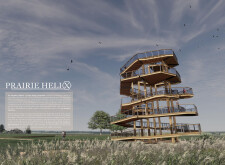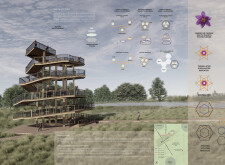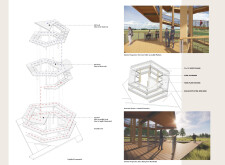5 key facts about this project
## Project Overview
The Prairie Helix is an architectural design submitted for the Legendary Highway 14 Tower Design Competition in De Smet, South Dakota. The project aims to create an observation tower that enhances visitors' connections to the surrounding landscape and promotes community engagement. The design reflects regional characteristics while providing a platform for community interaction and individual experience.
## Spatial Strategy
The conceptual framework of the Prairie Helix is centered on observation, orientation, and community interaction. The tower's helix form encourages a gradual ascent, creating layered views of the local landscape, including the city, Silver Lake, and surrounding homesteads. Each level of the structure is tailored to facilitate engagement with the environment, incorporating viewing areas, play spaces, and rest zones. This design not only fosters individual exploration but also serves as a gathering point for educational activities focused on local ecology and history.
## Materiality and Construction
The architectural composition features overlapping hexagonal platforms that ascend, reflecting both stability and the organic shapes of the prairie landscape. Selected materials include:
- **Wood (12x12 columns)**: Offers an organic quality that links to local craftsmanship and the environment.
- **Steel outriggers**: Provide structural integrity against environmental forces.
- **Wood plank decking**: Ensures comfort and safety for users while maintaining aesthetic coherence.
- **Steel wire mesh railings**: Allow for unobstructed views while ensuring visitor safety.
The tower is designed for universal accessibility, with the first level compliant with ADA standards, promoting inclusivity. An external boardwalk harmonizes with the landscape, enhancing user interaction with the surroundings. Dynamic, rotating platforms offer varied vistas as visitors ascend, encouraging curiosity and exploration throughout the tower.






















































